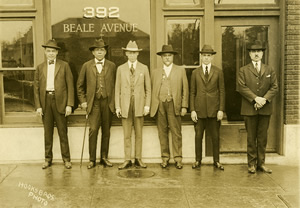Professional Services

Citizens Bank, founded in Nashville as the One-Cent Savings Bank in 1904, was the first bank to take on this challenge and achieve sustained growth. In his annual address to stockholders in 1912, R. H. Boyd noted that the guiding purpose of the bank was to restore “confidence in the already industrious colored citizens and training young men in financial dealings.” Although three other African American banks (e. g., Robert Reed Church, Sr.’s Solvent Savings Bank and Trust) emerged within the same decade, only Citizens Bank survived past 1930. The bank, in fact, is the oldest continuously operated African American bank in the United States.
The availability of insurance was another key component of financial stability for African American families. Fraternal and trade associations often offered insurance services during the late nineteenth century and into the twentieth. Some white-owned insurance firms marketed their services to African Americans, as the advertisements for the National Life and Accident Insurance Company and the Life and Casualty Insurance Company in the Nashville Globe illustrate. Although a major African American insurance firm did not emerge in Nashville, Memphis-based Universal Life Insurance Company, founded in 1923, provides the best example of the growth of an African American firm in the industry. This family business became the fourth largest African American insurance company in the country.
Business leaders likes James Napier and Richard H. Boyd recognized the value of increased home ownership and the need for African American real estate agents as catalysts for this effort. In a speech to National Negro Business League in 1901, Napier stated that real estate “is as necessary for colored men to engage for the advantage and well-being of the race as it is for us to have lawyers, preachers, doctors or merchants engaged in other financial pursuits.” Napier then praised “natural-born trader” Henry Harding for leading the way for other African Americans to enter the real estate business. Lewis Winter started Home Banking and Loan Association in the 1880s. Star Realty and Investment Company, formed in 1912, merged with Sunlight Realty and Investment Company in 1917.
The transition from house carpenters and brick and stonemasons, to builders following fashionable pattern books, to professional architects and skilled engineers, began in Middle Tennessee just before the Civil War, with the arrival in Knoxville of Joseph Baumann, the son of German immigrants who founded a local architectural dynasty, and Prussian immigrant Adolphus Heiman and State Capitol architect William Strickland in Nashville. In post-Civil War Tennessee, Gabriel Moses McKissack, whose father had learned brickmaking and became a master builder during enslavement in Maury County, trained two sons on local building projects in Pulaski, before they departed for Nashville and founded one of Tennessee’s first registered architectural firms. The firm of R.F. Graf in Knoxville, which designed and built prominent facades along Gay Street in the early 1900s and the Bandstand for the National Conservation Exposition in 1913, was founded by the grandson of a member the Swiss community that immigrated to Morgan County in the 1840s.
In Knoxville, Chattanooga, Nashville, and Memphis, professional photography studios, often owned by African Americans or ethnic immigrants, promoted the aspirations of up and coming citizens of Tennessee. In formal studio settings or on the street, photographers shaped the image of independent, self-sufficient African Americans or ambitious new arrivals from Europe who were building new lives in the cities. Whether making portraits, recording individuals at work and at play, or capturing the tempo of city life in vibrant business districts, the photographers themselves became agents of change in Tennessee society.